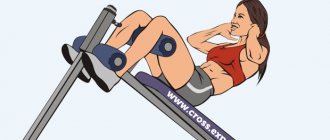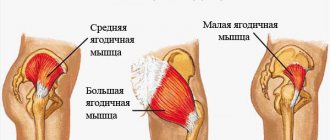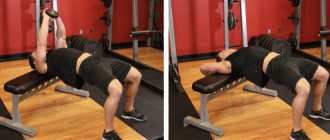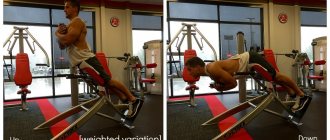What kind of guys do girls like? Confident and with toned muscles. If your muscle size leaves much to be desired, read this article! Here you will find a cool workout and tips from super pros.
When it comes to girls' attention, your trump card can be muscle training, which will increase muscle mass, and with it your chances of winning.
The law of sympathy is simple: girls like smart and pumped up guys. If you are smart, but your muscle mass tends to zero, then your girlfriend will still glance in the direction of that jock with prominent muscles. But can a girl resist her mind, coupled with big biceps and pumped up shoulders? That's right, she simply won't stand a chance! Therefore, especially for you, we have prepared this workout for gaining muscle mass and tips from a professional trainer to make your muscles grow.
Training program for muscle growth
There is no one-size-fits-all way to train muscles to maximize size and strength. The recipe for beautiful muscles consists of many individual ingredients, such as body type and age. However, there are some general rules that will help you avoid overtraining, improve muscle recovery after training, and speed up muscle growth.
First of all, you will need a complete training program for the week. Use the following fitness plan.
Reverse pyramid
Still not tired of the variety of pyramids? Then here’s another one for you – the opposite one. There is an opinion that it was invented by the famous bodybuilder Lee Labrada. Be that as it may, the principle of the reverse pyramid is as follows: the athlete performs a couple of warm-up approaches and immediately puts on a decent weight equal to 80-85% of 1RM. This roughly equates to 6-8 reps to failure. After completing this approach, the athlete reduces the weight and increases the number of repetitions. By and large, the reverse pyramid resembles the classic one - the only difference is in the number of warm-up approaches.
Bodybuilders consider this principle of working with weights to be the best in terms of muscle growth, but this approach is potentially dangerous. The fact is that one or two warm-up approaches may not be enough to warm up the muscles, ligaments and central nervous system. If you increase the number of warm-up approaches, then the reverse pyramid turns into a classic one. As an example of a reverse pyramid, let's again take the bench press with a 1RM of 120 kg.
What to do to make muscles grow?
The first thing you thought about was probably that you need to train more. This is exactly what most guys in the gym think, and this is why ideal muscles are beyond their reach. If you want to build more muscle, follow the principle that less is more.
One of the main reasons why athletes fail to get the physique they dream of is because they spend too much time working out. They either do too many sets, or train for too long, or train too often. Muscle mass grows during rest. What is their result? Overtraining! Their muscles have stopped growing and their strength levels are also stagnant. And in the most severe cases, such would-be bodybuilders face loss of muscle mass, illness and/or depression.
Many guys in the gym don't realize that after every workout, their body needs to first recover before it can grow. And this is true not only for the muscles, but also for the central nervous system.
Imagine a large hole in the ground. These are micro injuries in your muscles received during training. Fully rebuilding muscle means filling that hole in the ground, and building muscle can only be done by building a mound over the buried hole. When you push yourself too hard in the gym, you dig a hole too big to fill, which means you don't have the opportunity to accumulate a mound of muscle on top of it! This doesn't mean your muscles aren't growing well. They grow as they should, but the hole is too big.
It also happens: after looking at photographs of Ronnie Coleman or Iron Arnie, a beginner begins to train according to their programs, and then wonders why the arm muscles do not grow? This is because one of them is a professional and the other is a beginner. And with equal perseverance, they will get different results from the same program.
These massive magazine cover guys train twice a day, six days a week, doing 20 or more sets of each body part!
An inexperienced athlete thinks: “If these methods of training muscles made them so big, then the same principles must work for me!”
What many people don't realize is that it all has to do with steroids, growth hormones, and a host of other drugs combined with perfect genetics. And it's possible they don't have work or school to worry about.
Professionals are able to train much more than most people without suffering from any side effects. Their muscle training program is sometimes overwhelming for beginners and sometimes completely pointless for non-competitive bodybuilders. Trying to follow the workouts of professional bodybuilders will end in disaster for most, leaving many disappointed and some simply giving up on bodybuilding.
There is only one reason for this – an incorrectly selected training program for muscle growth.
Truncated pyramid
Another popular type of weight training in bodybuilding. Its essence is as follows: the athlete performs 2-3 warm-up approaches according to the principle of the classic pyramid, then sets the working weight and works with it in 3-5 approaches. The weight of the weight does not change - the athlete performs all approaches with the same weight. In the truncated pyramid, you build up fatigue from set to set, but it's the last set that's really hard.
What weight should I work with? It depends on the personal preference of the person training. This could be three sets of twelve reps or five sets of five reps.
Let's say you are able to bench press 100 kg while standing. Then the principle of working along a straight pyramid may look like this:
| Weight weight, kg | Repetitions | Load level from 1RM |
| 40 | 15 | 40% |
| 60 | 10 | 60% |
| 75 | 8 | 75% |
| 75 | 8 | 75% |
| 75 | 8 | 75% |
How to properly train muscles
So what is the ideal muscle training system to increase muscle size and strength? Below are the basic rules to follow when creating your own training plan to avoid overtraining and optimize muscle growth. Please note that these recommendations are suitable for bodybuilders who do not use steroids.
First rule: Train no more than 4 days a week
There is simply no need to train more than 4 days a week. Some people with poor muscle recovery abilities after exercise may benefit from training only 3 days a week. Work out when it's convenient for you, but make sure you pay attention to rule #2.
Second rule: Train no more than 2 days in a row.
After two days in a row in the gym, take 1-2 days off.
This is necessary for complete muscle recovery after training. If the average person exercises 3-4 days in a row, their immune system becomes compromised, making people more susceptible to illness or injury. Remember that you do not grow in the gym, but at home while you are resting. Only personal experiments will allow you to find the optimal dynamics and frequency of training.
This rule can be easily understood through the effect of Supercompensation, the post-training period during which the trained function has a higher rate compared to the initial level.
With every workout, muscle fibers are destroyed and key nutrients are depleted. This leads to a decrease in functionality. From this point on, your body will actively recover, increasing muscle protein synthesis to rebuild muscle tissue, bringing you back to your original level.
A period of supercompensation begins, during which your functionality exceeds your baseline level. This means that your muscles are growing faster than before. The next training session is best done at just such a moment.
Third rule: Workouts should last no more than 60-75 minutes
There is scientific evidence that after this period of time, the level of testosterone, which you need for muscle growth, begins to decrease, and the level of cortisol, a hormone that breaks down proteins and promotes the accumulation of fat, sharply increases.
Your body begins to produce cortisol in response to stress, fatigue and excessive exercise, so remember the rule that less is more. Otherwise, this hormone will drag your performance down, making it more difficult to achieve an anabolic growth-inducing state after finishing your workout.
Additionally, there is no reason to train muscles for long periods of time. If so, you may be doing too many sets and/or exercises, or you may be socializing too much in the gym. If you really want to become a cool, pumped up guy, come to the gym to train. Do what needs to be done first, and then exchange news.
If the previous training rules concerned planning, now the direct answer to the question “how to train muscles?”
Perform no more than 9 working approaches for large muscle groups, and no more than 5-6 for small muscle groups. First, let's be clear, 7-9 sets in this case means 3 sets of three exercises, not three exercises of 9 sets. If you focus and concentrate 100% of your mental and physical effort on each set of an exercise, there will be no reason to perform more sets.
Those who do 12, 15, or 20 sets for large muscle groups are simply not training hard enough, otherwise they wouldn't be able to sustain that number of sets. Anything beyond the required limits will not train your muscles and will only reduce your ability to recover after exercise. As a result, you can forget about muscle growth after training.
Rule Four: Perform compound exercises with free weights
Such exercises involve several muscle groups at once. And free weights are the best helpers in shaping the body and increasing muscles. Athletes achieved impressive results in the 1950s, 60s, and 70s using only barbells and dumbbells.
This is because the balance and concentration required to lift free weights activates more muscles, more muscle fibers and excites; nervous system stronger than exercise machines and blocks.
Ask the muscular guys you know how they built such massive muscles. Almost everyone will say that they built the majority of their mass with basic exercises such as the bench press, deadlift, squat, bench press, bent-over row, barbell curl, and dumbbell French bench press. There's nothing wrong with using machines and pulleys, but if you really want to impress, choose free weights in your muscle-building routine.
Fifth rule: Perform mostly 6-12 repetitions
Research has shown that low rep work (up to 5-6) tends to increase strength, while high rep work (13-20) builds muscular endurance. Both options promote muscle growth, but the best muscle hypertrophy can be achieved by working in the 6-12 rep range.
In this case, the muscle fibers are under tension for the ideal amount of time, and the load with sufficient stability affects growth. In a working set, muscle failure can be achieved anywhere between 6 and 12 repetitions. Read more about muscle failure in the article on training to failure.
Sixth rule: Always follow the technique
Doing all the exercises correctly will ensure that you are training exactly the muscles you want to work, and not wasting time. Anyone who “throws” weight when performing standing dumbbell raises or barbell curls is only deceiving himself. Light weight and proper technique can produce results in the form of prominent muscles, while heavy weight and “swinging” it only creates the illusion of strength.
Of course, it is sometimes necessary to use the snatch within reasonable limits, for example, when failure has already been reached and you need to do a few more repetitions.
Straight pyramid
In bodybuilding, a straight pyramid is most often used - the athlete reaches the “top” and completes the exercise. Let me give you a simple example on the bench press: let the 1RM in this exercise be equal to 150 kg. Schematically, a straight pyramid will look like this:
| Weight weight, kg | Repetitions | Load level from 1RM |
| 75 | 15 | 50% |
| 90 | 12 | 60% |
| 105 | 10 | 70% |
| 112,5 | 8 | 75% |
| 120 | 5-6 | 80% |
| 127,5 | 3-4 | 85% |
The percentages are approximate, the main rule is not to get tired on the first approaches. As a rule, 5-6 approaches are performed, no more. Usually the last approach is performed to failure, and cheating or help from a spotter is also used - all in order to squeeze out a couple more repetitions. This pyramid is very similar to Joe Weider's, but there are still minor differences. Thus, in the truncated pyramid the last “driving” approach is completely absent, and the weight is added in each approach.
Modern rehabilitation strategies: local versus global approach
Modern rehabilitation and core training strategies are based on the biomechanical idea of stabilization (2,16,18). Of particular interest is the increase in strength and endurance. When muscles are activated, core stiffness increases and stability increases. Bergmark divided the muscles that stabilize the spine into local and global (2). The transversus and multifidus muscles are classified as “local” muscles, while the erector spinae, quadratus lumborum, oblique and rectus abdominis muscles are classified as “global” (22).
There are two popular strategies for rehabilitation through core stabilization: the motor control exercise method, which emphasizes the need for specific exercises for local muscles, or the general exercise method, which involves exercises for global muscles (16,22). These strategies differ due to different interpretations of the biomechanical roles of local and global muscles (16, 22, 23).
Part 1. Modern concepts of assessment and impact
Low back injuries cause significant pain and dysfunction, which can impact athletic performance and lead to missed training. An athlete with back pain is often evaluated and treated by several specialists who make up the sports medicine team. Various types of conservative and invasive treatments are recommended, each with varying levels of effectiveness (5,12,13,16,22,23). The practice of using exercises in treatment is widespread. Core stabilization exercises (5,12,13,16,22,23) reduce pain, provide relief, restore/increase muscle function, develop stabilization abilities, and reduce the risk of subsequent injury. Although the general focus of exercise for patients with low back pain is core, there is disagreement among experts regarding the optimal assessment and intervention strategy (16,22,23). This article describes the core region and its stabilization, presenting the biomechanical basis for developing stabilization exercise programs, and analyzing 2 therapeutic strategies for the evaluation and rehabilitation of patients with low back pain.
Exercise technique
Neglecting the technique of performing exercises leads to a lack of results and injury. A huge number of people do not get the full benefit from their efforts precisely because they neglect the technique of doing the exercises.
There are 2 main reasons for this: the desire to use as much weight as possible and the initial successes of athletes who achieved them through intensive training, rather than exercise technique (which, as a rule, leaves much to be desired).
At the beginning of their career, when performing various exercises, novice athletes often make additional movements (bending, jerking, pushing, bending the body, transferring weights to other muscles, etc.), which make it easier to perform the exercises. No matter what exercise you perform, you must be absolutely sure that it only engages the muscles that you intend to train. To be sure of this, you should slightly reduce the weight used and slow down each repetition as much as possible.
The speed of training an exercise is not as important as the mental attitude to perform each repetition with the highest possible concentration. Never change the position of your body or limbs to make the exercise easier. Let every exercise and every repetition be as hard as it should be. As your experience increases, you will be rewarded for your efforts by increasing the rate at which your muscles grow.
Kegel exercises for pregnant and postpartum women
Pregnancy and childbirth are a difficult process for the body, during which the condition of the muscles in the pelvis plays a big role. Weak tone of other muscles of the body, although it can cause discomfort, is not so dangerous. Weakened pelvic muscles are fraught with painful, protracted labor, as well as decreased libido, prolapse and prolapse of the uterus, and urinary incontinence. Often women experience urine leakage, both during pregnancy (the fetus puts pressure on the bladder) and after childbirth. The second option awaits those who have poor muscle function. Therefore, doctors recommend training them in advance, monitoring their condition during pregnancy and maintaining muscle tone after childbirth.
While carrying a child, thanks to Kegel exercises for urinary incontinence, a woman's tissue elasticity increases, venous congestion decreases, joint mobility improves, intestinal function improves, and the risk of involuntary urine loss decreases. Kegel exercises to strengthen muscles are also important for the process of childbirth itself, since their condition directly affects the maintenance of pregnancy and recovery in the postpartum period.
It is convenient that the training can be carried out at home - Kegel exercises for women do not require a special room and exercise machine and can be performed at any time. You need to exercise before and after childbirth, since muscle elasticity is always needed. Before the baby is born, this will help him to be born, and after that it will speed up the healing of ruptures and prevent organ prolapse. Even after a cesarean section, exercise is beneficial because muscle tone in pregnant women is reduced due to gravity.
Modifications
| Weight weight, kg | Repetitions | Load level from 1RM |
| 60 | 15 | 50% |
| 80 | 10 | 65% |
| 102,5 | Max. | 85% |
| 90 | 8 | 75% |
| 80 | 7-8 | 67.5% |
| 70 | 12-15 | 60% |
Of course, you don't have to follow all of the above-mentioned weight training principles exactly. Don't like to vary the number of reps with each set? It's okay - you can work with a constant number of repetitions! You can complete all 5-6 sets of 10 repetitions, and this will not be considered a mistake. Ronnie Coleman did just that - you can easily see this by watching videos of his training. It is also possible for the athlete to first work in a truncated pyramid and then lower the weight, as in a reverse pyramid.
How to warm up before starting weight training?
womenshealthmag
Injury is the last thing you want to get from training. Therefore, before you start, you need to do a good warm-up, thereby reducing the risk of harming your body. And when we talk about warming up, we don't mean walking on a treadmill for 5 minutes while scrolling through Instagram. It is also not recommended to stretch: static stretching elements are best left for the final stage of training, since muscle stretching can destabilize muscles that have not yet been warmed up.
The ideal choice is to imitate the exercises you will perform during your workout. For example, let's say you're planning to do a weighted squat. During your warm-up, do a few squats and lunges using your body weight.
see also
No dumbbells or barbells: build muscles and get stronger with bodyweight exercises
Balasana (Child's Pose)
Source: @anna_gvanidze
To perform this asana, you need to sit on the floor (on the mat) on your knees so that the pelvis is pressed to the heels. We take a deep breath, and as we exhale, lower our stomach onto our thighs and our forehead onto the floor. We place our hands next to our legs - this is a very important point, since there is a variation of this pose, where we stretch our arms, on the contrary, forward.
This option does not provide complete relaxation, but helps to stretch the spine. Therefore, it is often used between asanas for a short break. While in Balasan, don’t forget about deep breathing (we’ll talk about it below).
Free weight exercises that can make you stronger.
Free weights aren't just about heavy barbells in the gym: they're weights of any weight that allow you to control your movements and pace as you perform an exercise.
While the concept can be a little confusing, free weights are the type of exercise equipment everyone is familiar with: dumbbells, kettlebells, barbells, medicine balls, and sandbags .
see also
15 effective exercises that will help you achieve strong, sculpted arms.
Anyone who's even a little familiar with the topic of fitness knows that structuring a workout can be a daunting task. How many repetitions and approaches are needed? How heavy should the weight be? What is a French press, and how to fit it into your workout? Do not worry. We have prepared answers to popular questions for you, as well as a list of weight training exercises that will make you stronger.
The CORE region and its stabilization
Athletic performance depends on the development and transmission of force between body segments. For example, during pre-motion, the surface reaction force passing through the pitcher's supporting leg is transmitted through the torso of the upper limb (12). Impaired transmission of force through the torso can lead to decreased performance and increase the athlete's risk of injury. When playing sports and other activities, the core region plays a unifying role, reducing the likelihood of back injuries (12). The Core includes the muscles and joints of the abdomen, spine, pelvis, and hips (12). These muscles have a dual role: stabilizing the spine, protecting against traumatic forces, and transmitting force through the body (12,16).
When treating an athlete with nonspecific low back pain, clinicians focus on dysfunction (eg, poor neuromuscular control or poor muscle endurance) identified during a musculoskeletal assessment and implement treatment interventions, including core stabilization exercises. 15,22,23). Stabilization is the process of reducing the appearance of abnormal or excessive symptoms from interacting articular surfaces.
By developing mechanical models, biomechanists describe energy sources (potential energy state and coupling between spinal segments), body stability (factors responsible for loads or external forces), elastic energy and stiffness (stiffness of joints resulting from muscle activity), and sufficient stability ( adequate activation during motor functions) to determine the needs for spinal stabilization (2,16,18).
The above biomechanical concepts, in addition to changes in core muscle motor control following injury (see upcoming discussion), explain segmental instability and the effects of spinal loads, and provide clinical rationale for increasing segmental stiffness (stabilization capacity) through targeted exercises ( 2,16,18,22).
There is no consensus on the definition of low back instability (1,15). Some use the clinical term functional lumbar segmental instability—FLSI (15,19). FLSI is the loss of the spine's ability to maintain its pattern of displacement under normal physiological loads (27). The phenomenon occurs with structural abnormalities of the osseous-ligamentous apparatus against the background of insufficient neuromuscular control (15,27).
A patient with FLSI may not show structural segmental instability (excessive motion of an overlying segment relative to an underlying segment) on radiographs, but may have segmental instability due to disruption of ligamentous constraints and insufficient segmental stiffness from inappropriate muscle activation (15,22). Assessing FLSI using clinical tests is challenging, however, symptoms associated with FLSI can be addressed with stabilization exercises (1,5,14,15,19,20).











